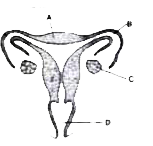Rupture of chordae tendineae:
Help the A-V valve to close
Prevent the bulging of A-V valve into the atria during contraction
Causes regurgination of blood into the atria during ventricular systole
Has no effect on haemodynamics of circulation
The correct Answer is:C
Step-by-Step Solution:
1. Understanding Chordae Tendineae: The chordae tendineae are cord-like structures that connect the atrioventricular (AV) valves (mitral and tricuspid valves) to the papillary muscles in the ventricles. They play a crucial role in the functioning of the heart by preventing the valves from inverting during ventricular contraction.
2. Function of Chordae Tendineae: The primary function of the chordae tendineae is to prevent the eversion (bulging) of the AV valves into the atria when the ventricles contract. This ensures that blood flows in the correct direction—from the atria to the ventricles and then out to the body or lungs.
3. Effect of Rupture: If the chordae tendineae rupture, they can no longer effectively support the AV valves. This leads to the inability of the valves to close properly during ventricular systole (the contraction phase of the heart).
4. Consequences of Rupture: The rupture results in regurgitation, which is the backflow of blood into the atria during ventricular contraction. This means that instead of blood being pushed out of the heart, some of it flows back into the atria, leading to inefficient circulation.
5. Conclusion: Therefore, the correct answer to the question regarding the effects of the rupture of chordae tendineae is that it causes regurgitation of blood into the atria during ventricular systole.
Final Answer: The rupture of chordae tendineae causes regurgitation of blood into the atria during ventricular systole.
---
Topper's Solved these Questions
- BODY FLUIDS AND CIRCULATIONS BOOK - CENGAGE BIOLOGY ENGLISHCHAPTER - BODY FLUIDS AND CIRCULATIONS EXERCISE - Exercise (Assertion - Reasoning Questions)
15 Videos
- BODY FLUIDS AND CIRCULATIONS BOOK - CENGAGE BIOLOGY ENGLISHCHAPTER - BODY FLUIDS AND CIRCULATIONS EXERCISE - ARCHIVES (Choose the correct option)
30 Videos
- BIOTECHNOLOGY:PRINCIPLES AND PROCESSESBOOK - CENGAGE BIOLOGY ENGLISHCHAPTER - BIOTECHNOLOGY:PRINCIPLES AND PROCESSESEXERCISE - ARCHIVES (Choose the correct option)
33 Videos
- ECOSYSTEMBOOK - CENGAGE BIOLOGY ENGLISHCHAPTER - ECOSYSTEMEXERCISE - ARCHIVES (CHOOSE THE CORRECT OPTION)
41 Videos
Similar Questions
Knowledge Check
If due to some injury the chordae tendineae of the tricuspid valve of the human heart is partially non-functional, what will be the immediate effect ?
AThe flow of blood into the aorta will be slowed downBThe pacemaker will stop workingCThe blood will tend to flow back into the left atriumDThe flow of blood into the pulmonary artery will be reduced
Slate the main functions of:
Chordae tendineae
View SolutionIf due to some injury the chordae tendineae of the tricuspid valve of the human heart is partially non-functional, what will be the immediate effect ?
View SolutionState the main function of
(i) Guard cells.
(ii) Thrombocytes.
(iii) Chordae tendineae.
(iv) beta-cells of pancreas.
(v) Cerebrospinal fluid.
View SolutionRead the following statements and select the correct option.
A. Damage to chordae tendinae of semilunar valves in aorta causes back flow of blood in left ventricle.
B. Closure of atrio-ventricular valves during ventricular systole generates first heart sound.
View SolutionState the exact location of the following
Chordae tendinae
View SolutionThe figure given below represents the female reproductive system of a mammal. Parts indicated by the guidelines A to D are as follows:

(A) Uterus
(B) Fallopian tube (oviduct)
(C) Ovary
(D) Vagina
(a) Give appropriate terms for each of the following:
(i) The onset of reproductive phase in a young female.
(ii) Rupture of follicle and release of ovum from the ovary
(iii) Monthly discharge of blood and disintegrated tissues in human female.
(iv) Process of fusion of ovum and sperm.
(v) Fixing of developing zygote on the uterine wall.
(vi) The permanent stoppage of menstruation at about the age of 45 years in a female.
(b) State the functions of the (0) Placenta (ii) Amniotic fluid. [ICSE 2004, 2015]
(c) Using the symbol "X' indicates the region in the diagram where fertilisation occurs.[ICSE 2004)
View SolutionMedulla of kidney is divided into a number of pyramids by invagination of cortex within medulla known as
(a) Chordae tendinae
(b) Columns of Bertini
(c) Cortical pyramids
(d) Duct Of Bellini
View Solution
